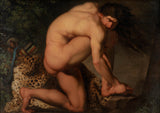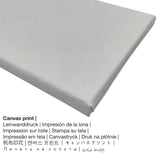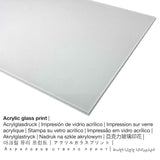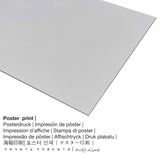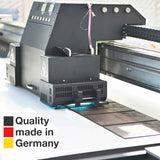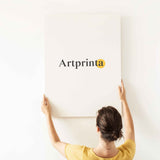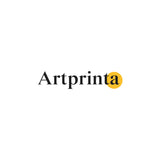Nicolai Abildgaard, 1775 - The Philoctetes Wounded - gravat artístic
Impost inclòs. Enviament calculat a la caixa.
Sobre aquesta pintura de més de 240 anys
El més 240 obres d'art d'un any van ser creades per la danès pintor Nicolai Abildgaard in 1775. The piece of art belongs to the Statens Museum for Kunst (Galeria Nacional de Dinamarca) 's col·lecció d'art, que és el museu de belles arts més gran de Dinamarca i que està adscrita al Ministeri de Cultura danès. Amb cortesia de Galeria Nacional de Dinamarca (domini públic).:. A més, l'alineació és paisatge and has a ratio of 1.4 : 1, which implies that the length is 40% longer than the width. Nicolai Abildgaard was a painter from Denmark, whose style can mainly be assigned to Romanticism. The Romanticist painter lived for a total of 66 anys, nascut a 1743 in Copenhagen and died in the year 1809 in Copenhagen.
Els materials del producte que poden triar els nostres clients
In the dropdown selection right next to the article you can pick your prefered size and material. The following options are available for individualization:
- Impressió de vidre acrílic (amb revestiment de vidre real): The print on acrylic glass, which is sometimes described as a UV print on plexiglass, makes the original work of art into wonderful wall décor and offers a distinct alternative to dibond and canvas prints. Your favorite artwork is manufactured with modern UV direct printing machines. The special effect of this are sharp and rich colors.
- Impressió dibond d'alumini: An Aluminium Dibond print is a material with a true depth effect. The non-reflective surface structure creates a fashionable impression. A direct Aluminium Dibond Print is your ideal introduction to art replicas with aluminum. For our Direct Aluminium Dibond option, we print the favorite artpiece right onto the surface of the white-primed aluminum composite. This direct print on aluminium is one of the most popular entry-level products and is a truly sophisticated way to showcase art, since it puts the viewer’s focus on the image.
- La impressió del cartell (material de tela): The poster print is a UV printed canvas paper with a nice surface finish. Please note, that depending on the absolute size of the poster print we add a white margin of something between 2-6cm around the print motif, which facilitates the framing.
- Impressió sobre tela: The canvas print is a printed cotton canvas mounted on a wooden frame. Canvas prints are relatively low in weight. That means, it is quite simple to hang your Canvas print without any wall-mounts. Canvas prints are suitable for any type of wall in your house.
Renúncia legal: We try our utmost to depict our products as closely as possible and to exhibit them visually on the respective product detail pages. Still, some colors of the print products and the print result might diverge somehwat from the presentation on your screen. Depending on your settings of your screen and the quality of the surface, not all colors are printed as exactly as the digital version. Because all fine art prints are printed and processed manually, there may as well be slight variations in the motif's size and exact position.
El producte
| Tipus de Producte: | reproducció d’art |
| Mètode de reproducció: | reproducció en format digital |
| Tècnica de fabricació: | Impressió directa UV (impressió digital) |
| Origen del producte: | produït a Alemanya |
| Tipus d'estoc: | On Demand |
| Ús previst del producte: | disseny de la llar, art de paret |
| Alineació de l'obra d'art: | alineació del paisatge |
| Relació d'aspecte: | 1.4: 1 - (longitud: amplada) |
| Implicació de la relació d'aspecte: | la longitud és un 40% més llarga que l'amplada |
| Materials disponibles del producte: | impressió sobre tela, impressió de pòsters (paper sobre tela), estampat de metall (dibond d'alumini), impressió de vidre acrílic (amb revestiment de vidre real) |
| Variants de tela sobre llitera (impressió sobre tela): | 70x50cm - 28x20 ", 140x100cm - 55x39" |
| Impressió de vidre acrílic (amb revestiment de vidre real) variants: | 70x50cm - 28x20 ", 140x100cm - 55x39" |
| Impressió de pòsters (paper de tela): | 70x50cm - 28x20 " |
| Variants de mida de la impressió d'alumini (material d'alumini dibond): | 70x50cm - 28x20 ", 140x100cm - 55x39" |
| Enquadrament de la còpia artística: | sense marc |
Informació d'obra d'art
| Títol del quadre: | "The Wounded Philoctetes" |
| Classificació: | pintura |
| Classificació artística: | art clàssic |
| Segle: | 18th segle |
| Creat l'any: | 1775 |
| Edat de les obres: | al voltant d’anys 240 |
| Museu: | Museu d'Estens per Kunst (Galeria Nacional de Dinamarca) |
| Ubicació del museu: | Copenhaguen, Dinamarca |
| URL del web: | Museu d'Estens per Kunst (Galeria Nacional de Dinamarca) |
| Llicència d'obres d'art: | domini públic |
| Cortesia de: | Galeria Nacional de Dinamarca |
Breu visió de l’artista
| Nom: | Nicolai Abildgaard |
| Gènere de l'artista: | masculí |
| Nacionalitat de l'artista: | danès |
| Feines: | pintor |
| País d'origen: | Dinamarca |
| Classificació de l'artista: | vell mestre |
| Estils d'art: | Romanticisme |
| Envelliment: | 66 anys |
| Any de naixement: | 1743 |
| Lloc de naixement: | Copenhaguen |
| Any de defunció: | 1809 |
| Mort a (lloc): | Copenhaguen |
Aquest text està protegit per drets d'autor © | www.artprinta.com (Artprinta)
General information from Statens Museum for Kunst (National Gallery of Denmark) (© Copyright - Statens Museum for Kunst (National Gallery of Denmark) - Museu d'Estens per Kunst (Galeria Nacional de Dinamarca))
From 1772 Abildgaard spent five years in Rome thanks to a scholarship granted by the Royal Danish Academy of Fine Arts in Copenhagen. It was while in Rome that he created this depiction of the legendary hero Philoctetes, whose screams of pain caused by a festering snakebite made his comrades-in-arms abandon him on a Greek island during the Trojan war.
Challenging neoclassicism The dominant and deeply rooted movement within figure painting at this time was neoclassicism with its emphasis on self-command and calm. Abildgaard challenges this pattern with his depiction of a body convulsively curved around an axis of pain; a body that feels like it is forcefully restrained within the picture field with its tense musculature and twisted limbs.
Avantgarde, pathos and Weltschmerz The 1770s brought with them an increased emphasis on grand passions among the Northern European ”avant-garde”, and this new outlook also left its mark on Abildgaard’s circles in Rome. The interest in pathos and Weltschmerz is clearly evident in his works from this era.
In this case he used a principal work of classical sculpture as the basis for his rendition of Philoctetes’ tormented state: The Torso Belvedere in the Vatican museum served as the model for the plastic and mannered rendition of the hero’s upper body. With this move, Abildgaard’s stylistic innovation was imbued with features of a work canonised by neoclassicism – without, however, reducing the tensions in the painting.

